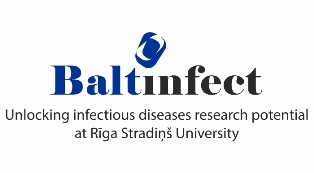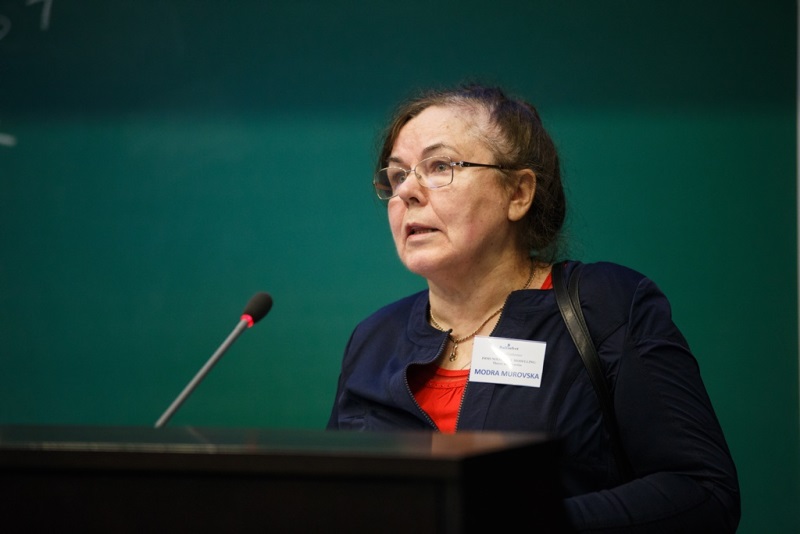RSU first in Latvia to develop immunological modelling in medicine
From 13 to 15 May, Rīga Stradiņš University (RSU) hosted the first Baltic Conference “Immunological Modelling: Theory and Practice” with 110 members from 14 countries, with 27 reports read and 19 poster presentations made. Associate Professor Modra Murovska, Director of Augusts Kirhenšteins Institute of Microbiology and Virology, speaks about the conference and immunological modelling in Latvia and worldwide.
Why was such an important event like the first Baltic Conference “Immunological Modelling: Theory and Practice” held in Rīga?
Since 2013, Rīga Stradiņš University has been the implementer of the project “Unlocking infectious diseases research potential at Rīga Stradiņš University (Baltinfect)” within the European Commission’s Framework Programme 7 REGPOT (Regional Research Potential), and it was the first supported EC REGPOT project in the area of health care in Latvia.
The funding of the project is not intended for scientific and research work, but rather as a form of support for the development of research staff to allow the researchers of the university to supplement their knowledge, skills and experience. Therefore, the project envisages an exchange of scientists between partner countries of the project, conferences, work group meetings, training and research seminars – the May conference “Immunological Modelling: Theory and Practice” was one of such project events.
As the conference was held during the Latvian presidency of the European Union Council, on 12 May we organised a Latvian Presidency event “European Union contribution to infectious disease research”, where 15 presentations were made on European Union achievements in the area of infectious disease development and what new EU Member States, especially Latvia, could give to Europe. This event included a constructive exchange of thoughts: how Europe could help us and what we expect from Europe for us to be able to compete with the old EU Member States and to successfully participate not only in such capacity-building projects, but as equal partners also in scientific research projects financially supported by the EU.
For us to be competitive in Europe, Latvia should unlock its scientific potential. However, since public support is negligible in this area, the only possibility right now is to participate in European capacity project tenders, but, if we succeed, these capacity projects can serve as a stepping stone to participate in “Horizon 2020” scientific research tenders, which would let us develop research in some certain areas of medical science.

Immunological modelling is a relatively new research method in medicine, which allows the use of statistics and computer modelling to study immune system functions and processes…
Yes, it is a new method in the world and not only in immunological modelling, but in medical modelling in general, and its development in Latvia is limited. Computer modelling or the so-called in silico studies are valuable in different areas of medicine providing for a significant reduction of time and funds invested into research. As one of the conference’s speakers said, models are never accurate, however, they are appropriate, when we need to choose a correct approach, to anticipate the progress of any process, to create the best vaccine, etc. When we are modelling from 100 different versions, we can choose 10 of the best versions and only check them in practice – in cell cultures, on mice and finally on people (clinical trials). Such a possibility significantly reduces the economic costs of studies. Immunological modelling is becoming more and more widespread all over the world, because many diseases are simply changes in the immune system caused by different factors.
This Latin expression means that something is made using a computer / computer simulation / computer modelling. The expression was coined using the analogy of Latin expressions in vivo and in vitro, which are used when we talk about experiments, which are carried out using living organisms or laboratory conditions, respectively.
What can Latvia offer Europe in this area?
In terms of methods and knowledge, we can offer the same as any old EU Member State, however, due to limited funding, we cannot develop ourselves to the required level of excellence. Very little money is devoted to science in Latvia, and our country is ranked as one of the last in Europe, if we take into account how much money from the gross domestic product is invested into the development of science.
Why was it a Baltic conference?
Because our project partners are researchers from Lithuania, Belarus and Poland. We attempt to involve our Estonian colleagues in the implementation of the project for it to cover the entire Baltic region.
Is the Augusts Kirhenšteins Institute of Microbiology and Virology the only institute in Latvia carrying out research using immunological modelling?
Our institute is the first in Latvia in the area of health care and medical modelling. We model how an infectious epidemic could develop, if it were to happen, and how a disease would develop, if we dispense one or another medicine, and so on. There are many opportunities in modelling – it is like a game of chess.
What scientific studies are carried out worldwide using immunological modelling?
This method is used to develop vaccines, such as the flu vaccine, which constantly changes.
Immunological modelling allows modelling the past as well – for example, how a specific disease had spread. At a conference in Germany, Professor Anne-Mieke Vandamme from Leuven University, Belgium, which is also a partner institution in the Baltinfect project, created a model of the potential development of HIV in the world.
What makes the conference hosted by RSU so important?
The majority of scientists involved in immunological modelling are not doctors or biologists, instead they are mathematicians, physicists or bioinformaticians. This was the first time that specialists from different areas, doctors and scientists working in the area of virology and bacteriology who study infectious diseases, met with modellers. Modellers need real data in order to be able to do their job. After the meeting at our conference, we already have several ideas for cooperation and potential further areas of research.

What should we learn from European researchers?
We have a lot to learn, of course, however, even now Europe is already interested in us, because we have many clinical trials – many patients were examined – and they can take this as a basis for modelling by adding their own data. To discover something important, the study should be sufficiently extensive, a large number of patients from all over Europe rather than one region only being examined.
What are the most important considerations after the conference?
The project “Unlocking infectious diseases research potential at Riga Stradins University” (Baltinfect) envisages that an immunological modelling laboratory will be created at the RSU Augusts Kirhenšteins Institute of Microbiology and Virology. We have already involved a scientist who will work in this laboratory, and he was the one who gained the most from this conference, because he will actually work in immunological modelling, as well as modelling in other areas of medicine.
We, as the others who work with patients in clinics or study clinical material in laboratories, understand, where we can use this modelling by processing data which we already have. And that is important.
When is the next Baltic conference on immunological modelling planned to be held?
It all depends on funding. If we will get the funds to do so – and we hope we will – another conference is bound to be organised.




